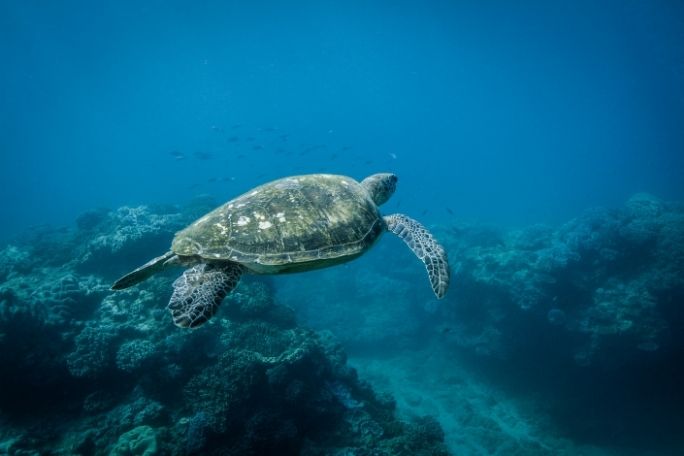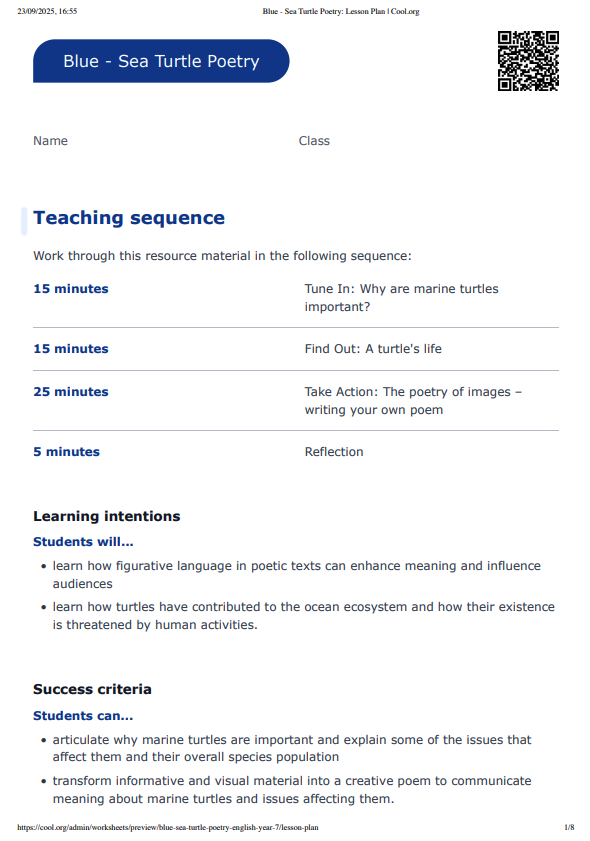Lesson summary
This lesson incorporates clips from Blue The Film as learning inspiration. In this finding out lesson, students will use visible thinking routines to respond to a clip exploring the impact of pollution and ghost nets on marine turtles. They will enhance their understanding of poetry and the significance of word choices that communicate meaning in a poem about the life cycle of a sea turtle produced as part of Blue The Film. Students develop their creative skills in selecting language and figurative devices to produce particular meaning and will create their own poem using visual images and factual material as stimulus.
Learning intentions:
Students will...
- learn how figurative language in poetic texts can enhance meaning and influence audiences
- learn how turtles have contributed to the ocean ecosystem and how their existence is threatened by human activities.
Success criteria:
Students can...
- articulate why marine turtles are important and explain some of the issues that affect them and their overall species population
- transform informative and visual material into a creative poem to communicate meaning about marine turtles and issues affecting them.
Lesson guides and printables
Curriculum links
Select your curriculum from the options below.
Lesson details
Skills
This lesson is designed to build students’ competencies in the following skills:
- communication
- creativity
- critical thinking
- social skills
- global citizenship
Curriculum Mapping
Australian curriculum (8.4) content descriptions:
Year 7 English:
- Create literary texts that adapt stylistic features encountered in other texts, for example, narrative viewpoint, structure of stanzas, contrast and juxtaposition (ACELT1625).
- Plan, draft and publish imaginative, informative and persuasive texts, selecting aspects of subject matter and particular language, visual, and audio features to convey information and ideas (ACELY1725).
Syllabus outcomes: EN4-6C
General capabilities: Literacy, Critical and Creative Thinking
Cross-curriculum priority: Sustainability
Relevant parts of Year 7 English achievement standards: Students demonstrate understanding of how the choice of language features, images and vocabulary affects meaning. Students understand how the selection of a variety of language features can influence an audience. They create texts showing how language features and images from other texts can be combined for effect. Students make presentations and contribute actively to class and group discussions, using language features to engage the audience.
Unit of work: Blue The Film: Our Oceans and Our Future
Time required: 90 mins.
UN Sustainable Development Goals
- Target 14.1: By 2025, prevent and significantly reduce marine pollution of all kinds, in particular from land-based activities, including marine debris and nutrient pollution.
Resources Required
- Student Worksheet – one per student
- Device capable of presenting a clip to the class
- Ghost Nets Factsheet
- Sharks Factsheet
- Turtles Factsheet
- Fishing Factsheet
- Poetic Devices Glossary
- A Turtle’s Life Poem
- Turtles and Ghost Nets Stimulus Images
Additional Info
Level of teacher scaffolding: Low – lead students in discussion.
Blue is a feature documentary film charting the drastic decline in the health of our oceans. With more than half of all marine life lost and the expansion of the industrialization of the seas, the film sets out the challenges we are facing and the opportunities for positive change. Blue changes the way we think about our liquid world and inspires the audience to action. Find out how to screen or download the film here. Along with the film is an ambitious global campaign to create advocacy and behaviour change through the #oceanguardian movement. To become an ocean guardian, see the website.
Related Professional Learning
How To Teach Sustainability With Hope
Quick summary: This course is for both primary and secondary teachers of all subjects, but especially for English, Science, Humanities and Geography teachers who are covering climate change and the cross-curriculum priority of sustainability.




Welcome back!
Don't have an account yet?
Log in with:
Create your free Cool.org account.
Many of our resources are free, with an option to upgrade to Cool+ for premium content.
Already have an account?
Sign up with:
By signing up you accept Cool.org's Terms and Conditions(Opens in new tab) and Privacy Policy(Opens in new tab).